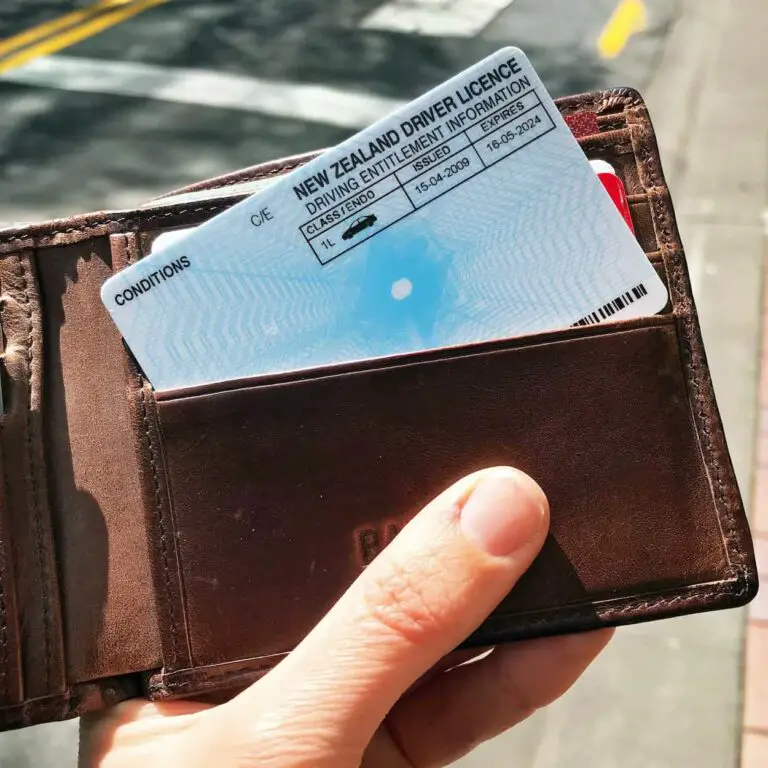Cost of Food in New Zealand: How Much To Budget? [2024]
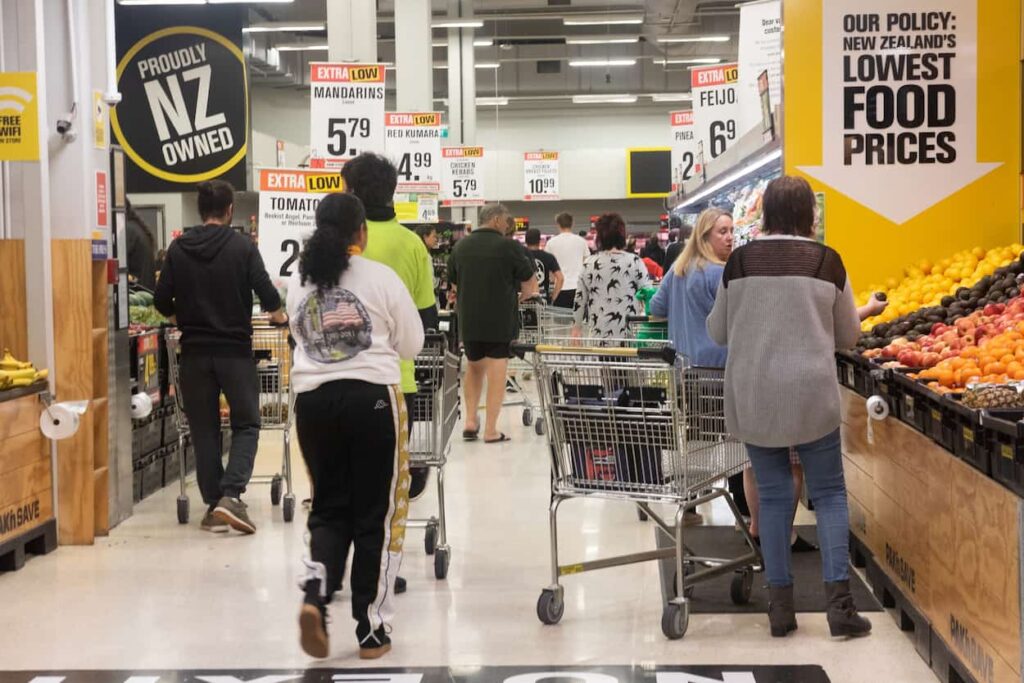
Did you know that farming is a major industry in New Zealand, contributing 5% of its GDP? Yes, the country is known for its exports of beef, sheep, and dairy products, but does that mean the cost of food in New Zealand is low?
Depending on the location, a single person in New Zealand spends between $107 and $134 weekly on food, while a couple will need $230. A family of four should budget $400 weekly to have a healthy diet. If you choose to eat out, expect to spend about $25 on a meal per person.
Food takes up a big chunk of your monthly budget, after housing. New Zealand has seen steep increases in prices, hence, you should keep an eye on recent developments to estimate your budget in 2024.
In this article, we discuss current food prices, average expenditures across various demographic groups, restaurant prices, and much more. This guide will be helpful whether you are moving to NZ or visiting.
Full, in-depth article on the cost of living in New Zealand, including my typical expenses.
To learn more about the living expenses in New Zealand, you can read our article on recommended budgets for a family.
How much does food cost in New Zealand?
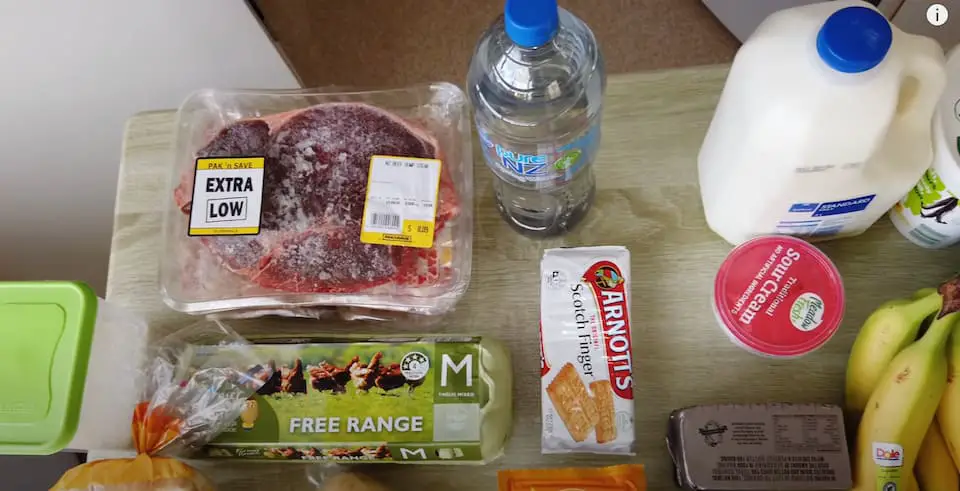
The increase in food prices in New Zealand has become a serious issue.
A recent report by the University of Otago has analyzed and surveyed food prices across main cities in New Zealand like Auckland, Wellington, Christchurch, and Dunedin.
According to the survey results, a single man needs $95 per week for a moderate choice of groceries. That means he doesn’t have to buy the cheapest products, but he also can not afford more expensive items like blueberries.
At the same time, a woman would need less money for a typical weekly shopping, about $80. And a family with two children should have at least $287 per week to spend on food.
Here is an overview of estimated weekly spending for food in New Zealand overall (2021):
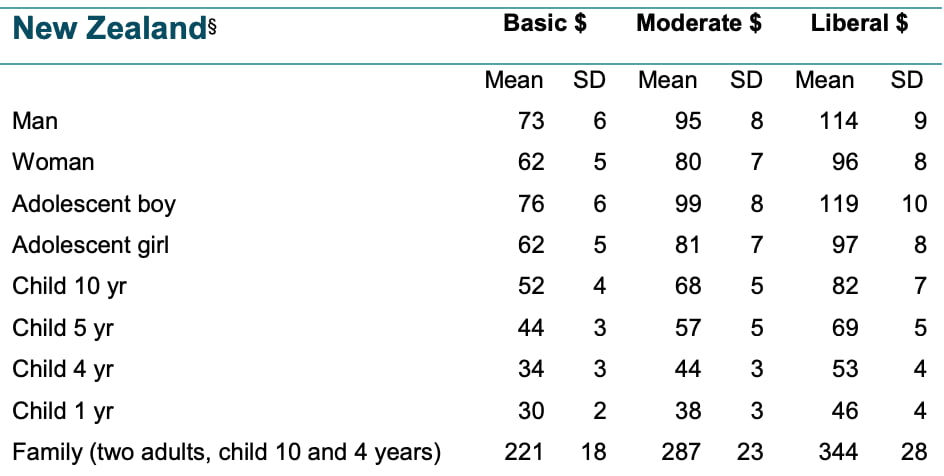
Here are estimated weekly expenditures in 2021 in main NZ cities for each category of consumers:
Wellington
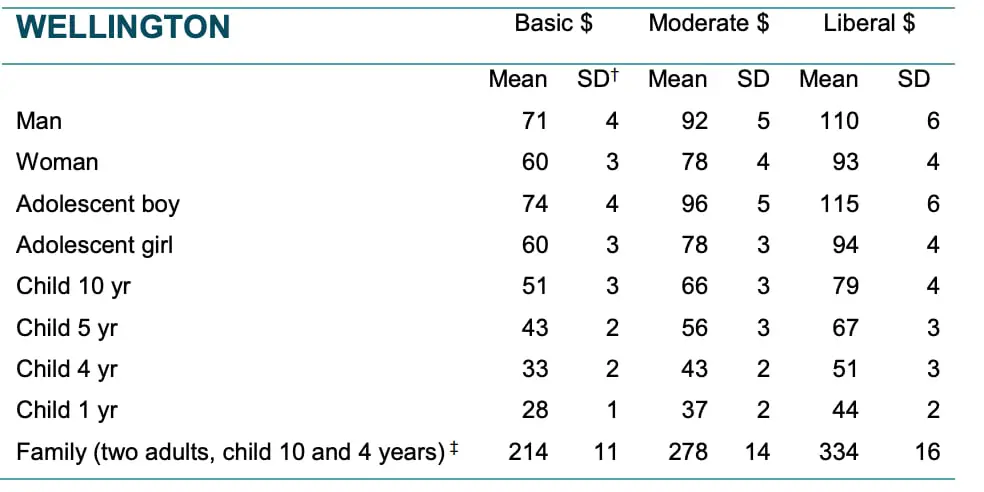
Christchurch
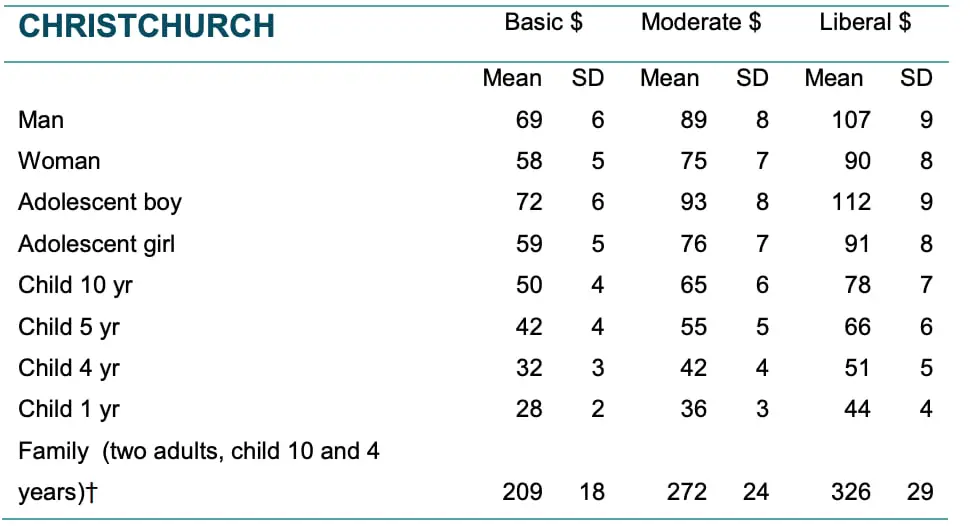
Prices in Auckland were recorded only in 2020, as follows.
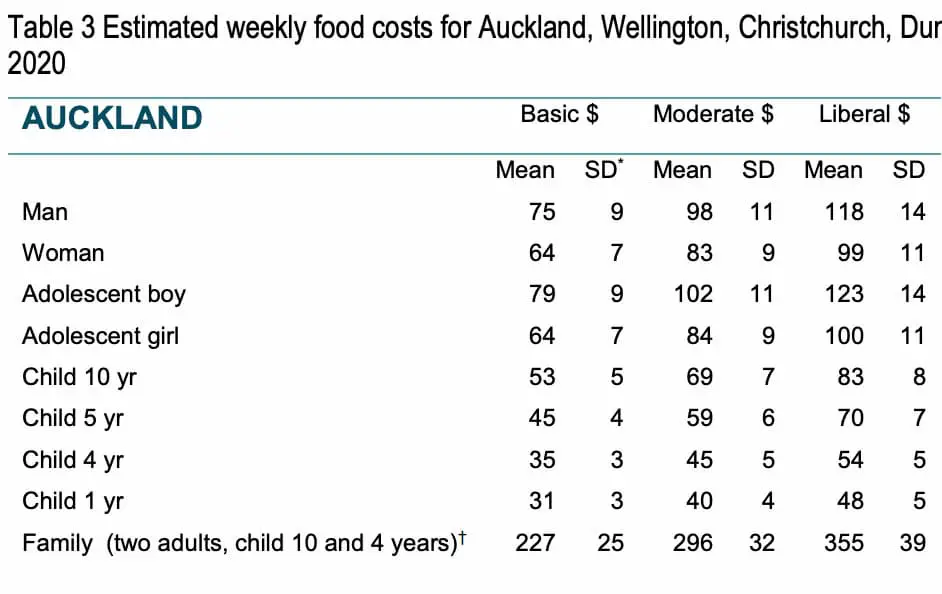
As you can see from the results, the food is more expensive in Auckland. Even in 2020, a man would need at least $98 per week for a moderate lifestyle.
In 2021, these numbers were certainly higher. At the same time, Christchurch is the cheapest city, with an average budget of $89 per week for a man and $75 for a woman.
Keep in mind that these results represent the minimum that you can spend on food. It also doesn’t include the costs of eating out. Therefore, in reality, you should budget more than this report suggests.
See the full report.
When talking about food prices in New Zealand, we should consider several aspects, including
- Location
- Number of people in your household
- Eating patterns
- Your diet preferences
- Various supermarkets and farmer’s shops
Estimate your food budget along with other expenses
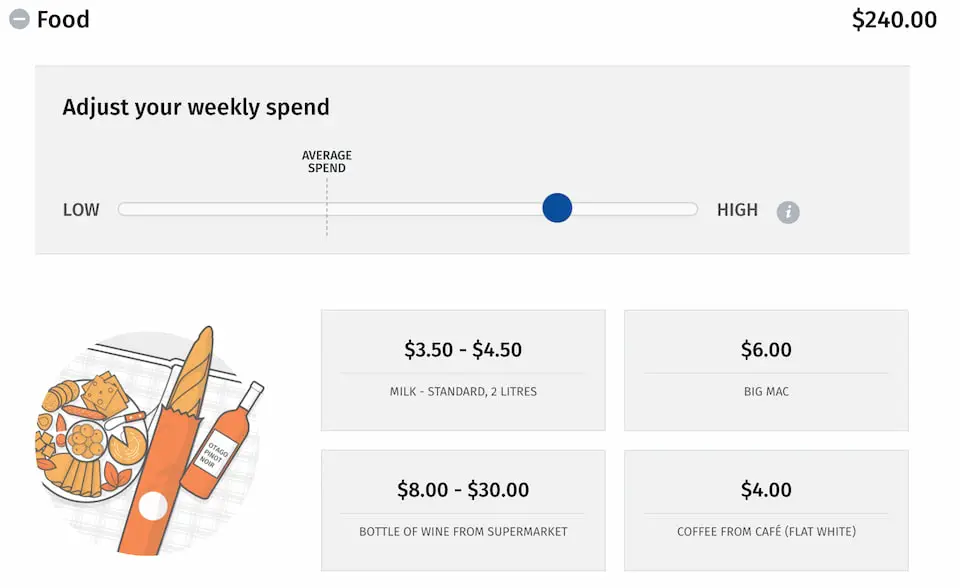
If you are curious about budgeting and the cost of living in New Zealand, you can use this handy tool provided by the government. There you can enter your location, your income, and average spending. It gives a good overview of some typical expenses you will face when living in New Zealand.
That said, where you live influences in a big way how much you spend on food. If you live in rural areas, you’ll spend less than in major cities like Auckland.
Here’s a comparative table showing the approximate cost of food in different parts of the country:
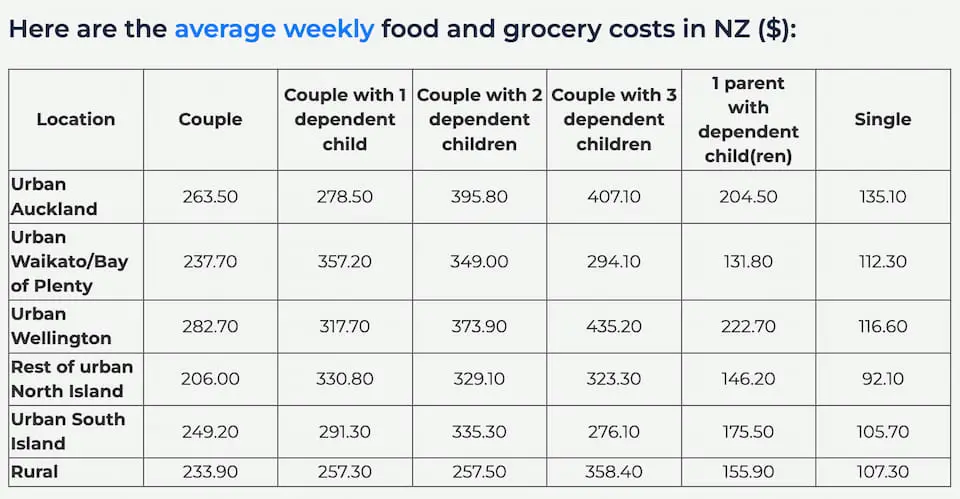
The number of people in your household also affects your food budget. A family of four will spend more than double the amount a single would spend on food and almost double what a couple spends.
Eating-out prices vary across New Zealand. That said, restaurant meals saw a 7.8% increase year on year. Here’s what you should expect to spend on food in an average establishment:
| Breakfast | Lunch | Dinner |
| $12 – $20 | $20 – $40 | $25 – $50 |
You can find cheaper restaurants where the prices are slightly below these figures and expect to spend double the amount when dining in high-end establishments.
If you plan to stay in the country for a long while, you need to budget appropriately for food. Here are tips on how you can minimize your food costs in New Zealand:
- Get your groceries in bulk to enjoy quantity discounts offered in most stores
- Shop at discounters like PAK’nSAVE
- If you’re a couple or a family, cook most of your meals at home to avoid the high restaurant costs
- Do a meal prep for a week
- Properly store leftovers for a future meal, you can take it as a lunch to work
- Get a coffee maker or coffee machine and make your coffee
- Make use of your store loyalty cards to shop for groceries
- Compare different store prices to get the best deals
- Shop at farmer’s markets
To help you organize your weekly food budget, you can classify the food items into these categories and then attach a figure to spend on each of them:
- Fruits and vegetables
- Cereals and grains
- Alcohol
- Meat, poultry, and fish
- Frozen vegetables and fruits
- Frozen meals
- Non-alcoholic drinks
- Ready-to-eat food
These hacks will help you save money spent on food and avoid wastage. Always have a list when shopping so you don’t buy unnecessary items. Besides, you will get the best deals when buying in bulk.
Before you settle on where to buy groceries, compare the prices in the major stores, which include:
- New World
- Countdown
- PAK’nSAVE
- Four Square
- Super Value
- Fresh Choice
Four Square is a typical dairy or convenience store. You can still buy some groceries there, but prices are higher, and the choice is small. So, it’s not a good idea to do a grocery haul in such a store.
Farmers markets
Farmer’s markets are great if you want fresh produce, but it’s not always cheaper than in the supermarket. You can get some good deals on particular items there, so they are worth checking out. Most towns have farmer’s markets each Saturday and Sunday.
With these facts in mind, here’s what you can expect to spend on food items on average in these stores in New Zealand (January 2023):
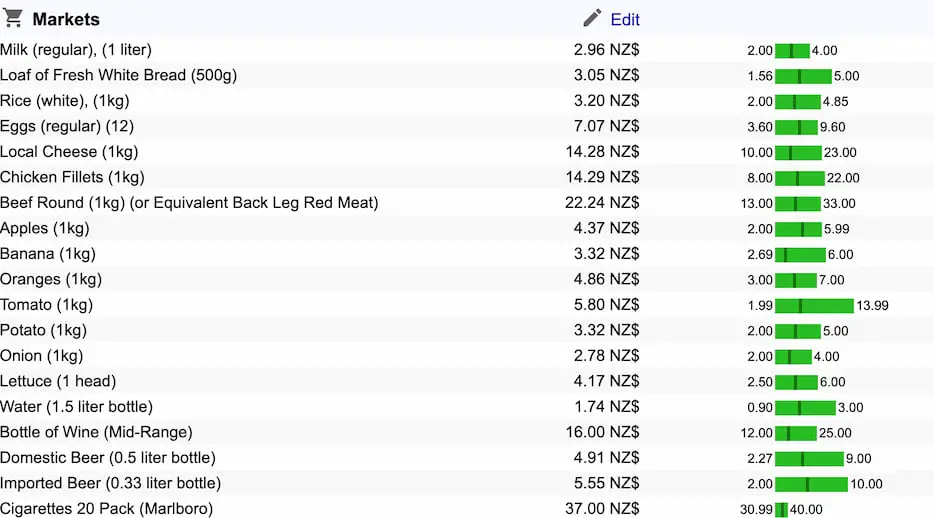
If you live in New Zealand and cook yourself most of the time, then your budget for food might average as follows:
| Meal | Average daily cost ($) | Weekly cost ($) | Monthly cost ($) |
| Breakfast | 10 | 70 | 280 |
| Lunch | 12 | 84 | 336 |
| Dinner | 12 | 84 | 336 |
| Total | 34 | 238 | 952 |
This budget includes occasional eating out and takeaways.
A single person will spend approximately $30 – 35 daily on food, while a couple can live on $50. A family of four should budget to spend between $50 and $80 daily, which corresponds to approximately $350 weekly and $1,500 monthly.
As a visitor in New Zealand, expect to spend approximately $100 (US$65) daily on food. If, however, you want to be frugal, you can alternate some meals with street foods that are cheaper and tasty too.
New Zealand’s most common street food include:
- Meatballs with spaghetti
- Various pies
- Pork Belly Steamed Buns
- Fried chicken
- Fish & Chips
- Hokey Pokey Ice Cream
- Kiwi burger
You’ll see food trucks and street vendors offering various meals & cuisines in the main cities such as Auckland, Wellington, and Christchurch. These are also common in street food markets which happen occasionally.
Some major restaurants also have street options where you order a takeaway from the retail section.
Check out New Zealand’s largest online shopping sites where you can buy more than only food.
Grocery prices
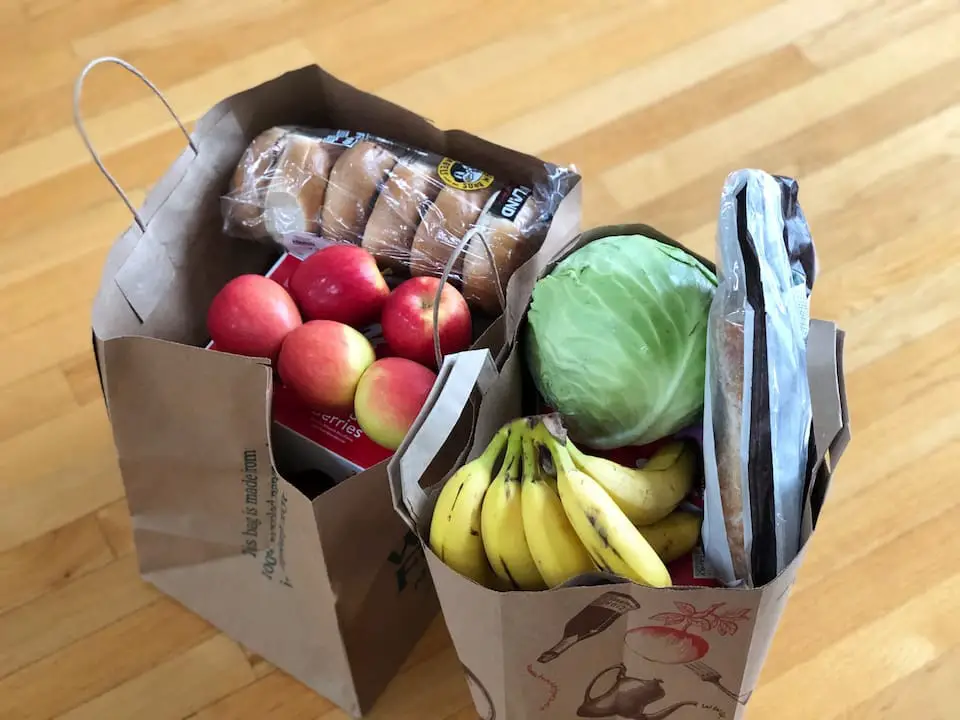
Update: Due to the worldwide recession and crisis, food prices are continuing to rise, so expect to see higher numbers when you do your shopping wherever you are.
Groceries prices are a pain point for many New Zealanders. You should budget around $200 (US$130) per week on grocery shopping as a single and $300 to $400 (US$200 – US$260) per week as a family just for groceries.
Besides, you can add $300 per month for several meals out with your family.
Even with high grocery prices, getting the items from the stores and making the food from home is cheaper than eating out daily.
If you want to cut the cooking time while still paying the same, you can check out HelloFresh. They deliver food kits for your weekly meals at affordable prices. You will enjoy their amazing, easy-done recipes for about $7.99 per meal.
Get up to $120 off on your order at HelloFresh.
Food prices in New Zealand in 2024
Food prices have been turbulent over the last few years in New Zealand, especially in 2023, with the rising recession. In fact, the country hasn’t experienced such increases in 32 years.
Food prices jumped 1.1% in December 2022 and were 11.3% higher than a year earlier (December 2021).
Fruit and vegetable have become as expensive as ever before, and they saw an increase of 23%, cost of restaurant meals and ready-to-eat food are now up by 7.8%.
Monthly change
When looking at how food prices change on a monthly basis, here is a comparison of food prices from December 2022 to November 2022:
- fruit and vegetable prices: + 5.9%
- meat, poultry, and fish prices: – 1.2%
- General grocery food prices: + 2%
- Non-alcoholic beverage: – 1.7%
- Restaurant meals and ready-to-eat food: + 0.6%
Annual change
December 2022 compared to December 2021:
- fruit and vegetable prices: + 23%
- meat, poultry, and fish prices: + 11%
- General grocery food prices: + 11%
- Non-alcoholic beverage: + 7.3%
- Restaurant meals and ready-to-eat food: + 7.8%
You can see how food prices have changed from the end of 2019 to the end of 2022.
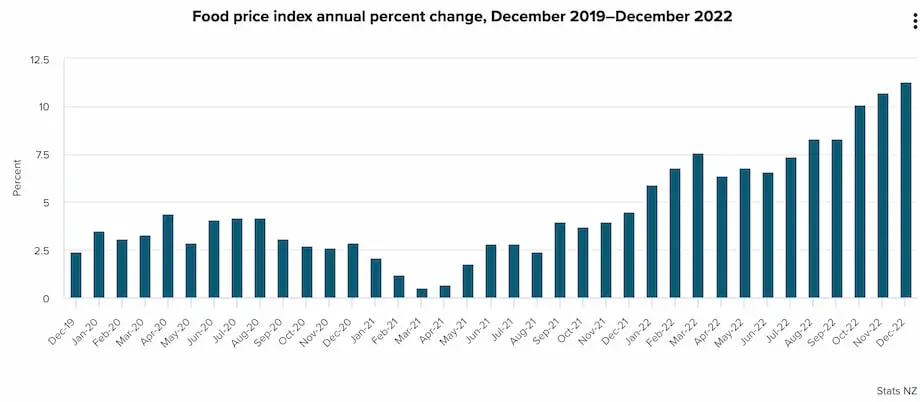
According to the consumer price index in the country, grocery food saw the highest increase in 2022 compared to other food items, as shown in the graph below:
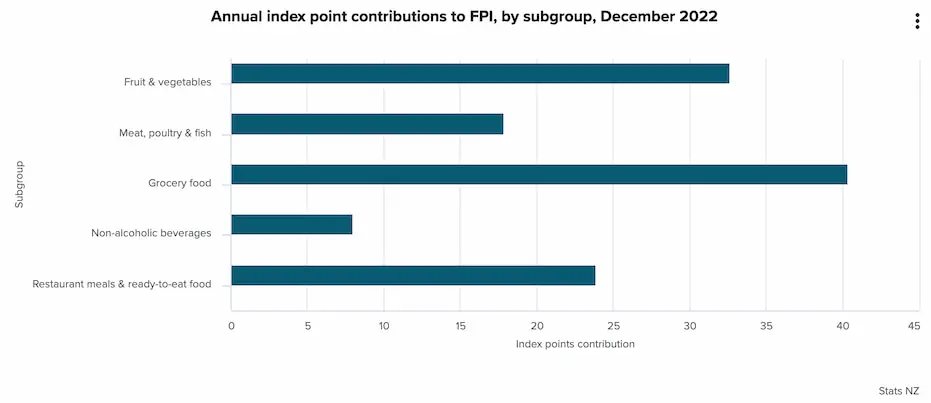
The high food price inflation under groceries was driven by the cost of tomato-based paste, yogurt, and noodles. Vegetables, broccoli, tomatoes, and capsicum were the most affected by the rapid price rise.
Consequently, in 2022, New Zealand experienced the highest food inflation over the last 32 years. The sharp rise in prices was orchestrated by several factors that include:
- Global inflation
- Global recession
- Russian invasion of Ukraine
- Supply chain hiccups due to the Russian invasion of Ukraine
- Increase in diesel prices
- Low harvest
- Labor shortage
- High farm input prices
The biggest casualties where the prices increased exponentially include:
| Food item | Increase in price 2022 (%) |
|---|---|
| Fruits and vegetables | 23% |
| Meat and fish | 11% |
| Beverages | 7.3% |
| Eggs | 16% |
The recession of 2023 is very considerable in New Zealand. However, economists say we aren’t there yet, and recession is yet to come.
Tomatoes were hit the hardest, resulting in high prices and acute shortage of the product. Labor shortage and the high cost of fertilizer and energy led to increases in prices for many vegetables.
Dairy products, however, had a strong year as exports of the main products, including milk powder, butter, and cheese, rose. Notably, the country exported more than $15 billion worth of milk powder.
Cut your expenses in New Zealand by housesitting – you pay zero rent!
Cost of meals out in New Zealand
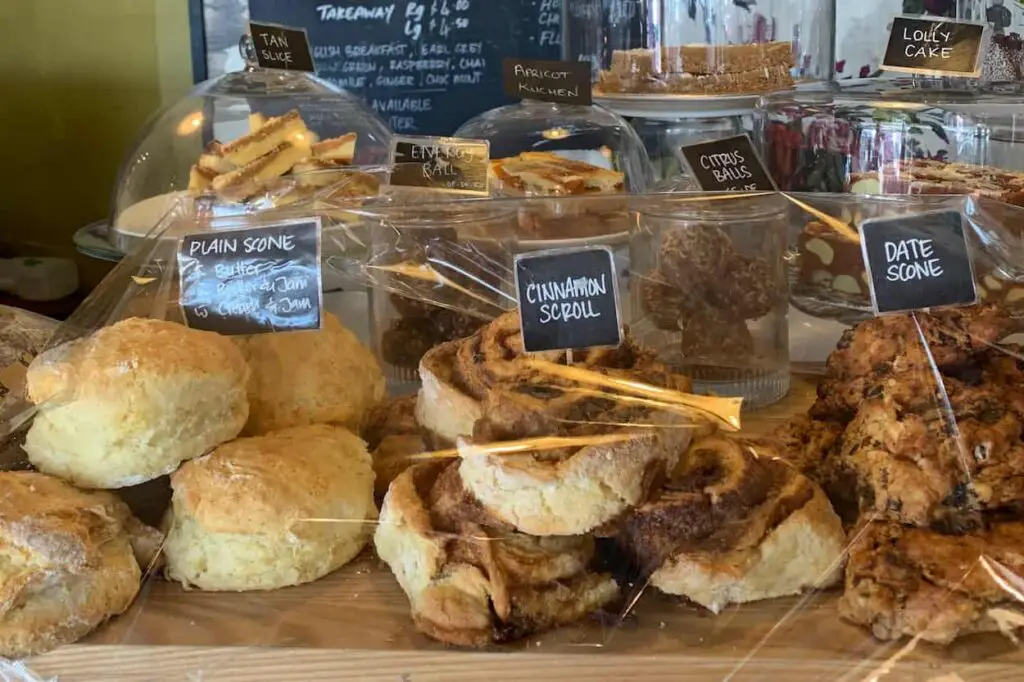
Meals out is a perfect way to break the cooking-at-home pattern and have a memorable time with friends and family. Yet, eating out is pretty pricey in New Zealand, but it’s generally cheaper than in the US.
New Zealand has plenty of cafes and restaurants. You will have a great dining experience. Besides, you don’t have to tip in New Zealand. It’s not expected and often not accepted. Waiters get paid a decent wage.
Generally, you have several options for this path: street food, cafes & coffee shops, and typical restaurants. Of course, you also visit high-end restaurants, but you won’t be reading this article then.
Here are some typical prices for meals and drinks out you will see across the country:
- Fast food meal: $8 – $14
- Breakfast: $12 – $20
- Regular meal: $25
- Dinner for two: $100 – $150
- Beer: $10
- Cappuccino: $5
- A cocktail: $18

You’ll save money and get to try tasty yet not very healthy meals if you enjoy street food. Street food is readily available across the country, with many great vendors happy to serve you. Street food is also seen in various foodcourts, which are often in shopping malls.
You get to choose your preferred cuisine as they have several options, from Indian, Chinese, Philippine, Caribbean, and Thailand.
Here’s a look at the main prices for street food in New Zealand:
| Meal | Average cost |
|---|---|
| Meat pie | $6 |
| Fish and chips | $12 – $20 |
| Sausages | $10 |
| Indian cuisine | $8 – $15 |
| Thai cuisine | $13 – $25 |
| Mexican cuisine | $10 – $20 |
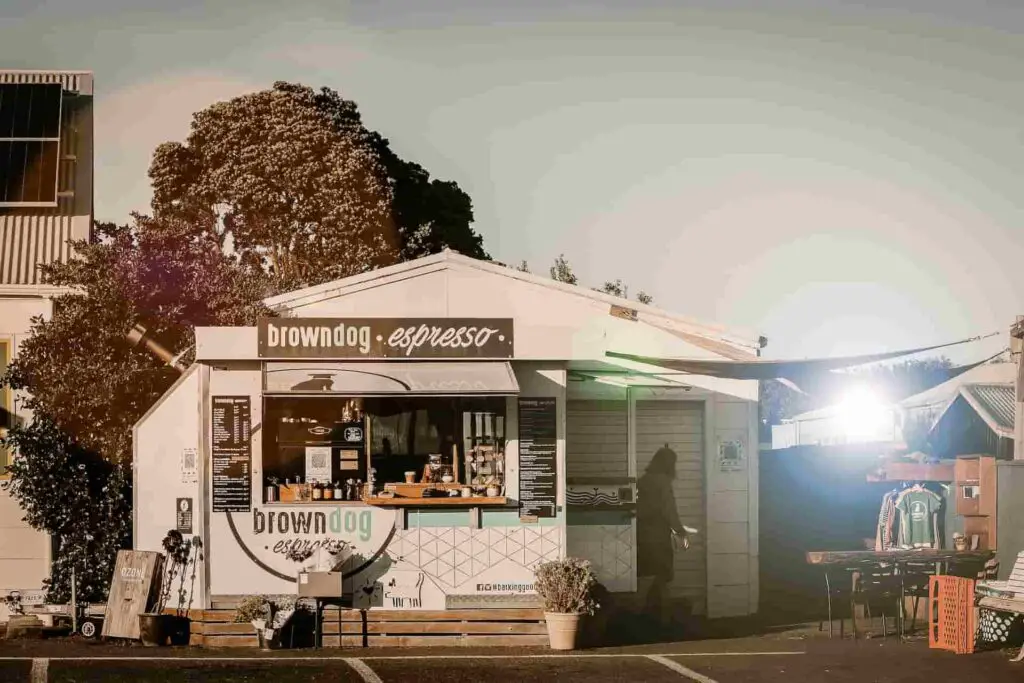
Your second option would be having a meal in an inexpensive restaurant. Food prices vary in such establishments as several factors, such as rent, location, size, and brand, come into play.
Here are some of the well-known fast food and least expensive restaurants:
- Vanguard coffee in Dunedin
- Canton cafe in Auckland
- Better Burger in Auckland
- Little Penang in Wellington
- Bonas Thai Cuisine in Auckland
- Revive in Auckland
- McDonald’s
- Burger King
- Mighty Hotdog in Auckland
Eating a meal from the cafe’s display window is pretty common. You just point at what you want, and the server will warm it up. The food is very fresh, so you don’t need to worry. It also tastes amazing, you would be surprised what you can get from the glass!
Moreover, New Zealand has plenty of options if you choose upscale and treat yourself to a fine-dining experience.
In such establishments, the service is top notch, the ambiance and food quality are on point, and you could even have a customized experience tailored just for you; this, however, comes at a cost.
Meals in these high-end establishments are expensive. They come in different courses, and the more they are, the higher the cost.
Some of the renowned fine end restaurants in New Zealand include:
- The Grove restaurant
- Sidart Restaurant
- The French Cafe
- Cocoro
- Meredith’s restaurant
Most of these establishments have a Michelin star, meaning they have been audited for quality, and their services are worth a try.
Meal prices in these restaurants are relatively high compared to mid-sized restaurants. These are the average food prices in high-end restaurants:
| Meal | Average cost |
| Starter | $30 |
| Main course | $50 |
| Dessert | $35 |
However, note that prices in high-end restaurants vary significantly from one restaurant to the next. Most of these restaurants also have a fixed menu option. The menu comprises the hotel’s most popular meals served at a fixed price in different courses.
For instance, a restaurant could charge $100 for a frisee starter salad, a main course of scallops served with mushrooms, and a dessert of raspberry sorbet and chocolate fondant.
The cost of alcoholic beverages and wine should be a key consideration as you plan where to go for a meal. When buying alcohol in a restaurant, expect to pay more than you would if you got it from a liquor store or your preferred grocery store.
A bottle of wine in the country’s major cities, such as Auckland, averages between $15 to $30, while half a liter of domestic beer goes for $10.
HelloFresh in NZ
HelloFresh is a meal kit delivery service. You get a box with all the ingredients that are portioned for the right number of meals. You just need to prepare it according to the instructions, and you get a home-cooked meal where half of the work was done by others.
They deliver the kit to your doorstep in all parts of New Zealand. To start with HelloFresh, you need to sign up for a subscription that you can cancel anytime (except cut-off times). The weekly cut-off time for any changes is 11:59 pm Tuesday.
There are other providers like Food Bag, but HelloFresh is by far the most popular one. They’ve got more than 30 recipes every week, so there’s lots of variety to choose from.
HelloFresh offers a flexible subscription with no minimum term or lock-in contract. You can also make changes and adjust your plan as needed (outside the cut-off time).
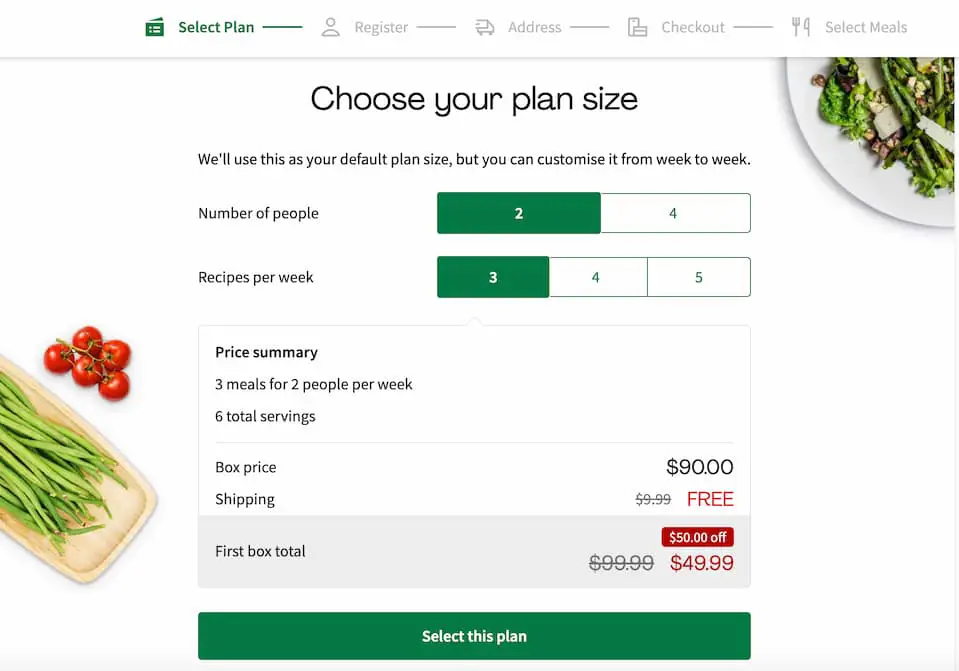
So what about the cost? Is it cheaper than buying groceries yourself? The price starts from around $99 that includes 3 recipes for 2 people. That means you will get 6 meals in total. The most cost-effective plan is $179 for a family of four for 4 recipes. Hence, you get 16 meals in total.
You can compare these prices to your average shopping bill. Usually, HelloFresh is slightly expensive, but not by a significant amount.
Pros of food kits
- Little bit more expensive than shopping.
- My Food Bag research in September found the prices were pretty much the same between the supermarket and the meal kits.
- Food kits often supply a sauce or a sachet of spices that would be hard to replicate without buying a lot of ingredients.
Cons of food kits
- You won’t have much left after cooking the meal. If you were buying in a supermarket in bulk, you would have more leftovers which can come in handy following days.
- Can be more expensive than buying food in the supermarket, especially if you shop at PAK’nSAVE.
To try out HelloFresh, use our link to get a $120 discount.
This post contains affiliate links. The affiliate link means we may earn an advertising/referral fee if you make a purchase through our link, without extra cost to you. It helps to keep this blog afloat. Thanks for your support.



![Can You Drink Tap Water in New Zealand? [2024]](https://simplenewzealand.com/wp-content/uploads/2023/05/fotor_2023-5-3_13_31_6-768x511.png)
![Top Highest Paying Jobs in New Zealand Without A Degree [2024]](https://simplenewzealand.com/wp-content/uploads/2023/03/karissa-best-NTgbsd3G8xc-unsplash-768x512.jpg)


